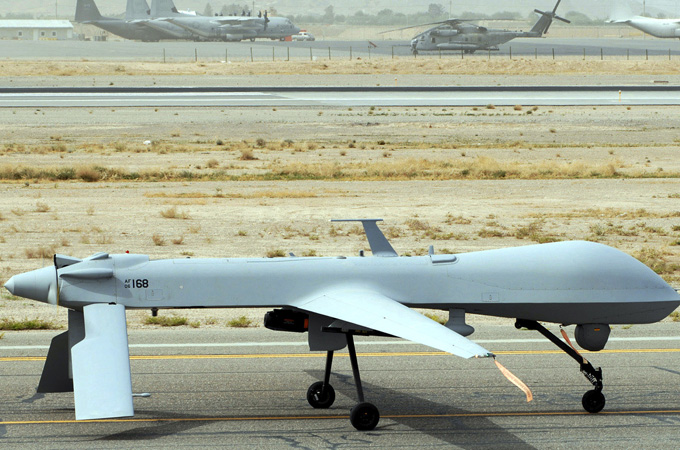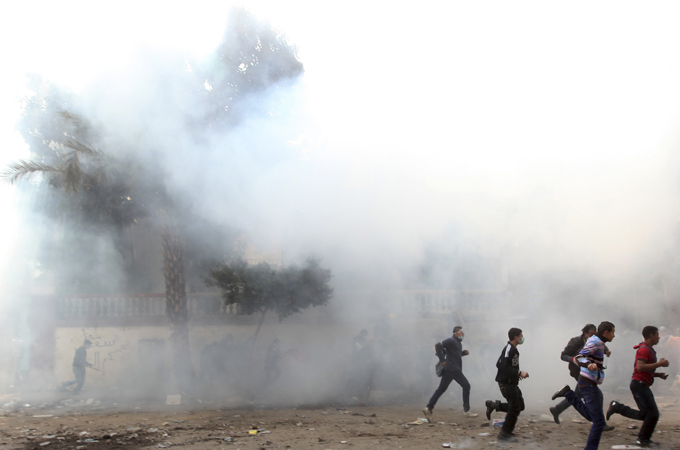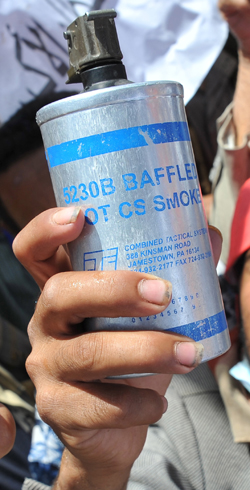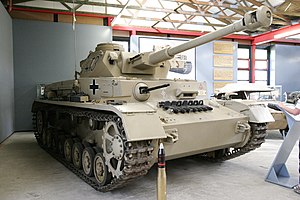 |
| A Panzer IV Ausf G. in desert colors, bearing the palm tree insignia of the 15th Panzer Division of the Afrika Korps. |
The Panzerkampfwagen IV (Pz.Kpfw. IV), commonly known as the Panzer IV, was a medium tank developed in Nazi Germany in the late 1930s and used extensively during the Second World War. Its ordnance inventory designation was Sd.Kfz. 161.
 |
| Panzer IV Ausf. C |
Designed as an infantry-support tank, the Panzer IV was not originally intended to engage enemy armor—that function was performed by the lighter Panzer III. However, with the flaws of pre-war doctrine becoming apparent and in the face of Soviet T-34 tanks, the Panzer IV soon assumed the tank-fighting role of its increasingly obsolete cousin. The most widely manufactured and deployed German tank of the Second World War, the Panzer IV was used as the base for many other fighting vehicles, including the Sturmgeschütz IV tank destroyer, the Wirbelwind self-propelled anti-aircraft weapon, and the Brummbär self-propelled gun, amongst others.
 |
| PzKpfw IV Ausf. D |
Robust and reliable, it saw service in all combat theaters involving Germany, and has the distinction of being the only German tank to remain in continuous production throughout the war, with over 8,800 produced between 1936 and 1945. Upgrades and design modifications, often made in response to the appearance of new Allied tanks, extended its service life. Generally these involved increasing the Panzer IV's armor protection or upgrading its weapons, although during the last months of the war with Germany's pressing need for rapid replacement of losses, design changes also included retrograde measures to simplify and speed manufacture.
 |
| The 300 horsepower Maybach HL 120TRM engine used in most Panzer IV production models. |
The Panzer IV was the most widely exported tank in German service, with around 300 sold to partners such as Finland, Romania, Spain and Bulgaria. After the war, the French and Spanish sold dozens of Panzer IVs to Syria, where they saw combat in the 1967 Six-Day War.
Origins
 |
| The short-barreled Panzer IV Ausf. F1. |
The Panzer IV was the brainchild of German general and innovative armored warfare theorist Heinz Guderian. In concept, it was intended to be a support tank for use against enemy anti-tank guns and fortifications. Ideally, the tank battalions of a panzer division were each to have three medium companies of Panzer IIIs and one heavy company of Panzer IVs. On 11 January 1934, the German army wrote the specifications for a "medium tractor", and issued them to a number of defense companies. To support the Panzer III, which would be armed with a 37-millimetre (1.46 in) anti-tank gun, the new vehicle would have a short-barrelled 75-millimetre (2.95 in) howitzer as its main gun, and was allotted a weight limit of 24 tonnes (26.46 short tons). Development was carried out under the name Begleitwagen ("accompanying vehicle"), or BW, to disguise its actual purpose, given that Germany was still theoretically bound by the Treaty of Versailles. MAN, Krupp, and Rheinmetall-Borsig each developed prototypes, with Krupp's being selected for further development.
 |
| The 1942 Panzer IV Ausf. F2 was an upgrade of the Ausf. F, fitted with the KwK 40 L/43 anti-tank gun to counter Soviet T-34 and KV tanks. |
The chassis had originally been designed with a six-wheeled interleaved suspension, but the German Army amended this to a torsion bar system. Permitting greater vertical deflection of the roadwheels, this was intended to improve performance and crew comfort both on- and off-road. However, due to the urgent requirement for the new tank, neither proposal was adopted, and Krupp instead equipped it with a simple leaf spring double-bogie suspension.
 |
| A Panzer IV Ausf H at the Musée des Blindés in Saumur, France, with its distinctive Zimmerit anti-magnetic mine coating, turret skirts, and wire-mesh side-skirts. |
The prototype required a crew of five men; the hull contained the engine bay to the rear, with the driver and radio operator, who doubled as the hull machine gunner, seated at the front-left and front-right, respectively. In the turret, the tank commander sat beneath his roof hatch, while the gunner was situated to the left of the gun breech and the loader to the right. The turret was offset 66.5 mm (2.62 in) to the left of the chassis center line, while the engine was moved 152.4 mm (6.00 in) to the right. This allowed the torque shaft to clear the rotary base junction, which provided electrical power to turn the turret, while connecting to the transmission box mounted in the hull between the driver and radio operator. Due to the asymmetric layout, the right side of the tank contained the bulk of its stowage volume, which was taken up by ready-use ammunition lockers.
 |
| The Ausf. J was the final production model, and was greatly simplified compared to earlier variants to speed construction. This shows an exported Finnish model. |
Accepted into service as the Versuchskraftfahrzeug 622 (Vs.Kfz. 622), production began in 1936 at Krupp-Grusonwerke AG's factory at Magdeburg.
Ausf. A to Ausf. F1
 |
| A Panzer IV Ausf. E showing signs of multiple hits to the turret, including the gun barrel. |
The first mass-produced version of the Panzer IV was the Ausführung, A (abbreviated to Ausf. A meaning "Batch A"), in 1936. It was powered by Maybach's HL 108TR, producing 250 PS (183.87 kW), and used the SGR 75 transmission with five forward gears and one reverse, achieving a maximum road speed of 31 kilometres per hour (19.26 mph). As main armament, the vehicle mounted the Kampfwagenkanone 37 L/24 (KwK 37 L/24) 75 mm (2.95 in) tank gun, which was a low-velocity gun designed to mainly fire high-explosive shells. Against armored targets, firing the Panzergranate (armor-piercing shell) at 430 metres per second (1,410 ft/s) the KwK 37 could penetrate 43 millimetres (1.69 in), inclined at 30 degrees, at ranges of up to 700 metres (2,300 ft). A 7.92 mm (0.31 in) MG 34 machine gun was mounted coaxially with the main gun in the turret, while a second machine gun of the same type was mounted in the front plate of the hull. The Ausf. A was protected by 14.5 mm (0.57 in) of steel armor on the front plate of the chassis, and 20 mm (0.79 in) on the turret. This was capable only of stopping artillery fragments, small-arms fire, and light anti-tank projectiles.
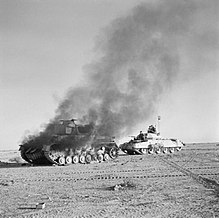 |
| A British Crusader tank passing a burning German Panzer IV during Operation Crusader, late 1941. |
After manufacturing 35 tanks of the A version, in 1937 production moved to the Ausf. B. Improvements included the replacement of the original engine with the more powerful 300 PS (220.65 kW) Maybach HL 120TR, and the transmission with the new SSG 75 transmission, with six forward gears and one reverse gear. Despite a weight increase to 16 t (18 short tons), this improved the tank's speed to 39 kilometres per hour (24 mph). The glacis plate was augmented to a maximum thickness of 30 millimetres (1.18 in), and the hull-mounted machine gun was replaced by a covered pistol port. Forty-two Panzer IV Ausf. Bs were manufactured before the introduction of the Ausf. C in 1938. This saw the turret armor increased to 30 mm (1.18 in), which brought the tank's weight to 18.14 t (20.00 short tons). After assembling 40 Ausf. Cs, starting with chassis number 80341 the engine was replaced with the improved HL 120TRM. The last of the 140 Ausf. Cs was produced in August 1939, and production changed to the Ausf. D; this variant, of which 248 vehicles were produced, reintroduced the hull machine gun and changed the turret's internal gun mantlet to an external one. Again protection was upgraded, this time by increasing side armor to 20 mm (0.79 in). As the German invasion of Poland in September 1939 came to an end, it was decided to scale up production of the Panzer IV, which was adopted for general use on 27 September 1939 as the Sonderkraftfahrzeug 161 (Sd.Kfz. 161).
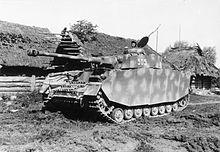 |
| A PzKpfw IV Ausf. H of the 12th Panzer Division operating on the Eastern Front in the USSR, 1944. |
In response to the difficulty of penetrating British Matilda Infantry tanks during the Battle of France, the Germans had tested a 50 mm (1.97 in) gun—based on the 5 cm PaK 38 L/60 anti-tank gun—on a Panzer IV Ausf. D. However, with the rapid German victory in France, the original order of 80 tanks was canceled before they entered production.
 |
| British officers inspect a German Pzkw-IV knocked out in France in June 1944 by the Durham Light Infantry. |
In September 1940 the Ausf. E was introduced. This had 50 millimetres (1.97 in) of armor on the bow plate, while a 30-millimetre (1.18 in) appliqué steel plate was added to the glacis as an interim measure. Finally, the commander's cupola was moved forward into the turret. Older model Panzer IV tanks were retrofitted with these features when returned to the manufacturer for servicing. Two hundred and eighty Ausf. Es were produced between December 1939 and April 1941.
 |
| Pzkw-IV in Belgrade Military Museum, Serbia. |
In April 1941 production of the Panzer IV Ausf. F started. It featured 50 mm (1.97 in) single-plate armor on the turret and hull, as opposed to the appliqué armor added to the Ausf. E, and a further increase in side armor to 30 mm (1.18 in). The weight of the vehicle was now 22.3 tonnes (24.6 short tons), which required a corresponding modification of track width from 380 to 400 mm (14.96 to 15.75 in) to reduce ground pressure. The wider tracks also facilitated the fitting of ice sprags, and the rear idler wheel and front sprocket were modified. The designation Ausf. F was changed in the meantime to Ausf. F1, after the distinct new model, the Ausf. F2, appeared. A total of 464 Ausf. F (later F1) tanks were produced from April 1941 to March 1942, of which 25 were converted to the F2 on the production line.
Ausf. F2 to Ausf. J
On May 26, 1941, mere weeks before Operation Barbarossa, during a conference with Hitler, it was decided to improve the Panzer IV's main armament. Krupp was awarded the contract to integrate again the same 50 mm (1.97 in) Pak 38 L/60 gun into the turret. The first prototype was to be delivered by November 15, 1941. Within months, the shock of encountering the Soviet T-34 medium and KV-1 heavy tanks necessitated a new, much more powerful tank gun. In November 1941, the decision to up-gun the Panzer IV to the 50-millimetre (1.97 in) gun was dropped, and instead Krupp was contracted in a joint development to modify Rheinmetall's pending 75 mm (2.95 in) anti-tank gun design, later known as 7.5 cm PaK 40 L/46. Because the recoil length was too long for the tank's turret, the recoil mechanism and chamber were shortened. This resulted in the 75-millimetre (2.95 in) KwK 40 L/43. When firing an armor-piercing shot, the gun's muzzle velocity was increased from 430 m/s (1,410 ft/s) to 990 m/s (3,250 ft/s). Initially, the gun was mounted with a single-chamber, ball-shaped muzzle brake, which provided just under 50% of the recoil system's braking ability. Firing the Panzergranate 39, the KwK 40 L/43 could penetrate 77 mm (3.03 in) of steel armor at a range of 1,830 m (6,000 ft).
The Ausf. F tanks that received the new, longer, KwK 40 L/43 gun were named Ausf. F2 (with the designation Sd.Kfz. 161/1). The tank increased in weight to 23.6 tonnes (26.0 short tons). One hundred and seventy-five Ausf. F2s were produced from March 1942 to July 1942. Three months after beginning production, the Panzer IV. Ausf. F2 was renamed Ausf. G. There was little to no difference between the F2 and early G models.
During its production run from May 1942 to June 1943, the Panzer IV Ausf. G went through further modifications, including another armor upgrade. Given that the tank was reaching its viable limit, to avoid a corresponding weight increase, the appliqué 20-millimetre (0.79 in) steel plates were removed from its side armor, which instead had its base thickness increased to 30 millimetres (1.18 in). The weight saved was transferred to the front, which had a 30-millimetre (1.18 in) face-hardened appliqué steel plate welded (later bolted) to the glacis—in total, frontal armor was now 80 mm (3.15 in) thick. This decision to increase frontal armor was favorably received according to troop reports on November 8, 1942, despite technical problems of the driving system due to added weight. At this point, it was decided that 50% of Panzer IV productions would be fitted with 30 mm thick additional armor plates. Subsequently on January 5, 1943, Hitler decided to make all Panzer IV with 80 mm frontal armor. To simplify production, the vision ports on either side of the turret and on the right turret front were removed, while a rack for two spare road wheels was installed on the track guard on the left side of the hull. Complementing this, brackets for seven spare track links were added to the glacis plate. For operation in high temperatures, the engine's ventilation was improved by creating slits over the engine deck to the rear of the chassis, and cold weather performance was boosted by adding a device to heat the engine's coolant, as well as a starter fluid injector. A new light replaced the original headlight, and the signal port on the turret was removed. On March 19, 1943, the first Panzer IV with Schürzen skirts on its sides and turret was exhibited. The double hatch for the commander's cupola was replaced by a single round hatch from very late model Ausf. G. and the cupola was up-armored as well. In April 1943, the KwK 40 L/43 was replaced by the longer 75-millimetre (2.95 in) KwK 40 L/48 gun, with a redesigned multi-baffle muzzle brake with improved recoil efficiency.
The next version, the Ausf. H, began production in April 1943 and received the designation Sd. Kfz. 161/2. This variant saw the integrity of the glacis armor improved by manufacturing it as a single 80-millimetre (3.15 in) plate. To prevent adhesion of magnetic anti-tank mines, which the Germans feared would be used in large numbers by the Allies, Zimmerit paste was added to all the vertical surfaces of the tank's armor. The vehicle's side and turret were further protected by the addition of 5-millimetre (0.20 in) side-skirts and 8-millimetre (0.31 in) turret skirts. During the Ausf. H's production run its rubber-tired return rollers were replaced with cast steel; the hull was fitted with triangular supports for the easily-damaged side-skirts. A hole in the roof, designed for the Nahverteidigungswaffe, was plugged by a circular armored plate due to shortages of this weapon. These modifications meant that the tank's weight jumped to 25 tonnes (27.56 short tons), reducing its speed, a situation not improved by the decision to adopt the Panzer III's six-speed SSG 77 transmission, which was inferior to that of earlier-model Panzer IVs.
Despite addressing the mobility problems introduced by the previous model, the final production version of the Panzer IV—the Ausf. J—was considered a retrograde from the Ausf. H. Born of German necessity to replace heavy losses, it was greatly simplified to speed production. The electric generator that powered the tank's turret traverse was removed, so the turret had to be rotated manually. The space was later used for the installation of an auxiliary 200-litre (44 imp gal) fuel tank; road range was thereby increased to 320 kilometres (198.84 mi), The pistol and vision ports in the turret were removed, and the engine's radiator housing was simplified by changing the slanted sides to straight sides. In addition, the cylindrical muffler was replaced by two flame-suppressing mufflers. By late 1944, Zimmerit was no longer being applied to German armored vehicles, and the Panzer IV's side-skirts had been replaced by wire mesh, while to further speed production the number of return rollers was reduced from four to three.
In a bid to augment the Panzer IV's firepower, an attempt was made to mate a Panther turret—carrying the longer 75 mm (2.95 in) L/70 tank gun—to a Panzer IV hull. This was unsuccessful, and confirmed that the chassis had, by this time, reached the limits of its adaptability in both weight and available volume.
Production
The Panzer IV was originally intended to be used only on a limited scale, so initially Krupp was its sole manufacturer. Prior to the Polish campaign, only 262 Panzer IVs were produced: 35 Ausf. A; 42 Ausf. B; 140 Ausf. C; and 45 Ausf. D. After the invasion of Poland, and with the decision to adopt the tank as the mainstay of Germany's armored divisions, production was extended to the Nibelungenwerke factory (managed by Steyr-Daimler-Puch) in the Austrian city of St. Valentin. Production increased as the Ausf. E was introduced, with 223 tanks delivered to the German army. By 1941, 462 Panzer IV Ausf. Fs had been assembled, and the up-gunned Ausf. F2 was entering production. The yearly production total had more than quadrupled since the start of the war.
As the later Panzer IV models emerged, a third factory, Vomag (located in the city of Plauen), began assembly. In 1941 an average of 39 tanks per month were built, and this rose to 83 in 1942, 252 in 1943, and 300 in 1944. However, in December 1943, Krupp's factory was diverted to manufacture the Sturmgeschütz IV, and in the spring of 1944 the Vomag factory began production of the Jagdpanzer IV, leaving the Nibelungenwerke as the only plant still assembling the Panzer IV. With the slow collapse of German industry under pressure from Allied air and ground offensives — in October 1944 the Nibelungenwerke factory was severely damaged during a bombing raid — by March and April 1945 production had fallen to pre-1942 levels, with only around 55 tanks per month coming off the assembly lines.
Combat history
The Panzer IV was the only German tank to remain in both production and combat throughout World War II, and measured over the entire war it comprised 30% of the Wehrmacht's total tank strength. Although in service by early 1939, in time for the occupation of Czechoslovakia, at the start of the war the majority of German armor was made up of obsolete Panzer Is and Panzer IIs. The Panzer I in particular had already proved inferior to Soviet tanks, such as the T-26, during the Spanish Civil War.
Western Front and North Africa (1939–1942)
When Germany invaded Poland on 1 September 1939, its armored corps was composed of 1,445 Panzer Is, 1,223 Panzer IIs, 98 Panzer IIIs and 211 Panzer IVs; the more modern vehicles amounted to less than 10% of Germany's armored strength. The 1st Panzer Division had a roughly equal balance of types, with 17 Panzer Is, 18 Panzer IIs, 28 Panzer IIIs, and 14 Panzer IVs per battalion. The remaining panzer divisions were heavy with obsolete models, equipped as they were with 34 Panzer Is, 33 Panzer IIs, 5 Panzer IIIs, and 6 Panzer IVs per battalion. Although the Polish army possessed less than 200 tanks capable of penetrating the German light tanks, Polish anti-tank guns proved more of a threat, reinforcing German faith in the value of the close-support Panzer IV.
Despite increasing production of the medium Panzer IIIs and IVs prior to the German invasion of France on 10 May 1940, the majority of German tanks were still light types. According to Heinz Guderian, the Wehrmacht invaded France with 523 Panzer Is, 955 Panzer IIs, 349 Panzer IIIs, 278 Panzer IVs, 106 Panzer 35(t)s and 228 Panzer 38(t)s. Through the use of tactical radios and superior tactics, the Germans were able to outmaneuver and defeat French and British armor. However, Panzer IVs armed with the KwK 37 L/24 75-millimetre (2.95 in) tank gun found it difficult to engage French tanks such as Somua S35 and Char B1. The Somua S35 had a maximum armor thickness of 55 mm (2.17 in), while the KwK 37 L/24 could only penetrate 43 mm (1.69 in) at a range of 700 m (2,296.59 ft). Likewise, the British Matilda Mk II was heavily armored, with at least 70 mm (2.76 in) of steel on the front and turret, and a minimum of 65 mm on the sides.
Although the Panzer IV was deployed to North Africa with the German Afrika Korps, until the longer gun variant began production, the tank was outperformed by the Panzer III with respect to armor penetration. Both the Panzer III and IV had difficulty in penetrating the British Matilda II's thick armor, while the Matilda's 40-mm QF 2 pounder gun could knock out either German tank; its major disadvantage was its low speed. By August 1942, Rommel had only received 27 Panzer IV Ausf. F2s, armed with the L/43 gun, which he deployed to spearhead his armored offensives. The longer gun could penetrate all American and British tanks in theater at ranges of up to 1,500 m (4,900 ft). Although more of these tanks arrived in North Africa between August and October 1942, their numbers were insignificant compared to the amount of matériel shipped to British forces.
The Panzer IV also took part in the invasion of Yugoslavia and the invasion of Greece in early 1941.
Eastern Front (1941–1945)
With the launching of Operation Barbarossa on 22 June 1941, the unanticipated appearance of the KV-1 and T-34 tanks prompted an upgrade of the Panzer IV's 75 mm (2.95 in) gun to a longer, high-velocity 75 mm (2.95 in) gun suitable for antitank use. This meant that it could now penetrate the T-34 at ranges of up to 1,200 m (3,900 ft) at any angle. The 75 mm (2.95 in) KwK 40 L/43 gun on the Panzer IV could penetrate a T-34 at a variety of impact angles beyond 1,000 m (3,300 ft) range and up to 1,600 m (5,200 ft). Shipment of the first model to mount the new gun, the Ausf. F2, began in spring 1942, and by the summer offensive there were around 135 Panzer IVs with the L/43 tank gun available. At the time, these were the only German tanks that could defeat the Soviet T-34 or KV-1. They played a crucial role in the events that unfolded between June 1942 and March 1943, and the Panzer IV became the mainstay of the German panzer divisions. Although in service by late September 1942, the Tiger I was not yet numerous enough to make an impact and suffered from serious teething problems, while the Panther was not delivered to German units in the Soviet Union until May 1943. The extent of German reliance on the Panzer IV during this period is reflected by their losses; 502 were destroyed on the Eastern Front in 1942.
The Panzer IV continued to play an important role during operations in 1943, including at the Battle of Kursk. Newer types such as the Panther were still experiencing crippling reliability problems that restricted their combat efficiency, so much of the effort fell to the 841 Panzer IVs that took part in the battle. Throughout 1943, the German army lost 2,352 Panzer IVs on the Eastern Front; some divisions were reduced to 12–18 tanks by the end of the year. In 1944, a further 2,643 Panzer IVs were destroyed, and such losses were becoming increasingly difficult to replace. By the last year of the war, the Panzer IV was outclassed by the upgraded T-34-85, which had an 85 mm (3.35 in) gun, and other late-model Soviet tanks such as the 122 mm (4.80 in)-armed IS-2 heavy tank. Nevertheless, due to a shortage of replacement Panther tanks, the Panzer IV continued to form the core of Germany's armored divisions, including elite units such as the II SS Panzer Corps, through 1944.
In January 1945, 287 Panzer IVs were lost on the Eastern Front. It is estimated that combat against Soviet forces accounted for 6,153 Panzer IVs, or about 75% of all Panzer IV losses during the war.
Western Front (1944–1945)
Panzer IVs comprised around half of the available German tank strength on the Western Front prior to the Allied invasion of Normandy on June 6, 1944. Most of the 11 panzer divisions that saw action in Normandy initially contained an armored regiment of one battalion of Panzer IVs and another of Panthers, for a total of around 160 tanks, although Waffen-SS panzer divisions were generally larger and better-equipped than their Heer counterparts.Regular upgrades to the Panzer IV had helped to maintain its reputation as a formidable opponent. Despite overwhelming Allied air superiority, the Norman bocage countryside in the US sector heavily favored defense, and German tanks and anti-tank guns inflicted horrendous casualties on Allied armor during the Normandy campaign. On the offensive, however, the Panzer IVs, Panthers and other armored vehicles proved equally vulnerable in the bocage, and counter-attacks rapidly stalled in the face of infantry-held anti-tank weapons, tank destroyers and anti-tank guns, as well as the ubiquitous fighter bomber aircraft. That the terrain was highly unsuitable for tanks was illustrated by the constant damage suffered to the side-skirts of the Ausf. H's; essential for defence against shaped charge anti-tank weapons such as the British PIAT, all German armored units were "exasperated" by the way these were torn off during movement through the dense orchards and hedgerows.
The Allies had also been developing lethality improvement programs of their own; the widely-used American-designed M4 Sherman medium tank, while mechanically reliable, suffered from thin armor and an inadequate gun. Against earlier-model Panzer IVs, it could hold its own, but with its 75 mm M3 gun, struggled against the late-model Panzer IV (and was unable to penetrate the frontal armor of Panther and Tiger tanks at virtually any range). The late-model Panzer IV's 80 mm (3.15 in) frontal hull armor could easily withstand hits from the 75 mm (2.95 in) weapon on the Sherman at normal combat ranges, though the turret remained vulnerable.
The British up-gunned the Sherman with their highly effective QF 17 pounder anti-tank gun, resulting in the Firefly; although this was the only Allied tank capable of dealing with all current German tanks at normal combat ranges, few (about 300) were available in time for the Normandy invasion. The other British tank with the 17 pdr gun could not participate in the landings and had to wait for port facilities. It was not until July 1944 that American Shermans, fitted with the 76 mm (2.99 in) M1 tank gun, began to achieve a parity in firepower with the Panzer IV.
However, despite the general superiority of its armored vehicles, by August 29, 1944, as the last surviving German troops of Fifth Panzer Army and Seventh Army began retreating towards Germany, the twin cataclysms of the Falaise Pocket and the Seine crossing had cost the Wehrmacht dearly. Of the 2,300 tanks and assault guns it had committed to Normandy (including around 750 Panzer IVs), over 2,200 had been lost. Field Marshal Walter Model reported to Hitler that his panzer divisions had remaining, on average, five or six tanks each.
During the winter of 1944–45, the Panzer IV was one of the most widely used tanks in the Ardennes offensive, where further heavy losses—as often due to fuel shortages as to enemy action—impaired major German armored operations in the West thereafter. The Panzer IVs that took part were survivors of the battles in France between June and September 1944, with around 260 additional Panzer IV Ausf. Js issued as reinforcements.
Variants
 |
| A Syrian Panzer IV Ausf. G, captured during the Six-Day War, on display in the Yad La-Shiryon Museum, Israel. |
In keeping with the wartime German design philosophy of mounting an existing anti-tank gun on a convenient chassis to give mobility, several tank destroyers and infantry support guns were built around the Panzer IV hull. Both the Jagdpanzer IV, initially armed with the 75-millimetre (2.95 in) L/48 tank gun, and the Krupp-manufactured Sturmgeschütz IV, which was the casemate of the Sturmgeschütz III mounted on the body of the Panzer IV, proved highly effective in defense. Cheaper and faster to construct than tanks, but with the disadvantage of a very limited gun traverse, around 1,980 Jagdpanzer IV's and 1,140 Sturmgeschütz IVs were produced. The Jagdpanzer IV eventually received the same 75 millimeter L/70 gun that was mounted on the Panther.
 |
| A Jagdpanzer IV/48 tank destroyer, based on the Panzer IV chassis, mounting the 75 mm PaK L/48 anti-tank gun. |
Another variant of the Panzer IV was the Panzerbefehlswagen IV (Pz.Bef.Wg. IV) command tank. This conversion entailed the installation of additional radio sets, mounting racks, transformers, junction boxes, wiring, antennas and an auxiliary electrical generator. To make room for the new equipment, ammunition stowage was reduced from 87 to 72 rounds. The vehicle could coordinate with nearby armor, infantry or even aircraft. Seventeen Panzerbefehlswagen were converted from Ausf. J chassis, while another 88 were based on refurbished chassis.
 |
| The Wirbelwind armored anti-aircraft vehicle. |
The Panzerbeobachtungswagen IV (Pz.Beob.Wg. IV) was an artillery observation vehicle built on the Panzer IV chassis. This, too, received new radio equipment and an electrical generator, installed in the left rear corner of the fighting compartment. Panzerbeobachtungswagens worked in cooperation with Wespe and Hummel self-propelled artillery batteries.
 |
| A Sturmpanzer IV Brummbär infantry-support gun (Casemate MG variant (flexible mount)). |
Also based on the Panzer IV chassis was the Sturmpanzer IV Brummbär 150-millimetre (5.91 in) infantry-support self-propelled gun. These vehicles were primarily issued to four Sturmpanzer units (Numbers 216, 217, 218 and 219) and used during the battle of Kursk and in Italy in 1943. Two separate versions of the Sturmpanzer IV existed, one without a machine gun in the mantlet and one with a machine gun mounted on the mantlet of the casemate. Furthermore, a 105-millimetre (4.13 in) artillery gun was mounted in an experimental turret on a Panzer IV chassis. This variant was called the Heuschrecke, or Grasshopper. Another 105 mm artillery/anti-tank prototype was the 10.5 cm K (gp.Sfl.) nicknamed Dicker Max.
Four different self-propelled anti-aircraft vehicles were built on the Panzer IV hull. The Flakpanzer IV Möbelwagen was armed with a 37-millimetre (1.46 in) anti-aircraft cannon; 240 were built between 1944 and 1945. In late 1944 a new Flakpanzer, the Wirbelwind, was designed, with enough armor to protect the gun's crew and a rotating turret, armed with the 20mm quadmount Flakvierling anti-aircraft cannon system; at least 100 were manufactured. Sixty-five similar vehicles were built, named the Ostwind, but with a single 37-millimetre (1.46 in) anti-aircraft cannon instead. This vehicle was designed to replace the Wirbelwind. The final model was the Flakpanzer IV Kugelblitz, of which only five were built. This vehicle featured a covered turret armed with twin 30-millimetre (1.18 in) anti-aircraft cannons.
Although not a direct modification of the Panzer IV, some of its components, in conjunction with parts from the Panzer III, were utilized to make one of the most widely-used self-propelled artillery chassis of the war—the Geschützwagen III/IV. This chassis was the basis of the Hummel artillery piece, of which 666 were built, and also the 88 millimetres (3.46 in) gun armed Nashorn tank destroyer, with 473 manufactured. To resupply self-propelled howitzers in the field, 150 ammunition carriers were manufactured on the Geschützwagen III/IV chassis.
















